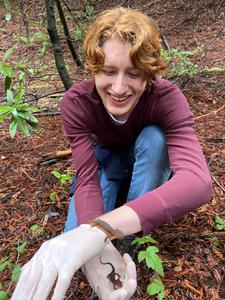Splash Biography
KANNON PEARSON, Graduate student obsessed with toxic amphibians!
|
Major: Integrative Biology College/Employer: UC Berkeley Year of Graduation: G |

|
Brief Biographical Sketch:
I am originally from El Paso, Texas but I have lived in the Bay Area for seven years. I transferred to UC Berkeley from Foothill Community College as an undergrad, and am so excited to be back for my PhD! In my spare time, I enjoy cooking for others, going on hikes to look for reptiles and amphibians, sketching, and watching Marvel movies. Past Classes(Clicking a class title will bring you to the course's section of the corresponding course catalog)S996: Animal toxins in natural history museums: the good, the bad, and the ugly in Splash Fall 2022 (Oct. 29, 2022)
Legend holds that, in the 1950s, three men were found dead at a campsite. There were no wounds. And no weapons. The killer? A poisonous California newt which had fallen into their coffee pot. In this 2-hour course we will teach you about some of the powerful poisons and terrifying toxins found in animals, and you will get the chance to see preserved museum specimens of toxic toads, poison frogs, venomous snakes, newts, monarch butterflies, and many more! Our research group is part of the Museum of Vertebrate Zoology and studies animal toxins. Museums are important places for research, and UC Berkeley has multiple natural history museums containing millions of specimens from all parts of the world. This course will also introduce you to natural history museums and the ways that biologists utilize these institutions.
S906: Animal toxins in natural history museums: the good, the bad, and the ugly in Splash Spring 2022 (Apr. 16 - Oct. 29, 2022)
Legend holds that, in the 1950s, three men were found dead at a campsite. There were no wounds. And no weapons. The killer? A poisonous California newt which had fallen into their coffee pot. In this 2-hour course we will teach you about some of the powerful poisons and terrifying toxins found in animals, and you will get the chance to see preserved museum specimens of toxic toads, poison frogs, venomous snakes, newts, monarch butterflies, and many more! Our research group is part of the Museum of Vertebrate Zoology and studies animal toxins. Museums are important places for research, and UC Berkeley has multiple natural history museums containing millions of specimens from all parts of the world. This course will also introduce you to natural history museums and the ways that biologists utilize these institutions.
X909: Transferring From a Community College in Splash Spring 2022 (Apr. 16 - Oct. 29, 2022)
Did you know that transfer students have a higher admissions rate to UC Berkeley than freshmen? Or that transferring can enable you to finish half of your bachelors for a fraction of the cost? Or that you can take your challenging lower division prerequisites in classes of 50 students instead of 500?
In this class we will discuss an alternative, nontraditional educational route: completing the first two years of your bachelors at a community college before transferring to a four-year university. We will discuss the social, financial, and educational benefits and drawbacks of this approach based on our own experiences as students who transferred to UC Berkeley.
Please come with any and all questions you may have about community college, Berkeley, admissions applications, undergraduate research, and more!
|
|
